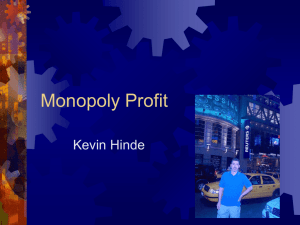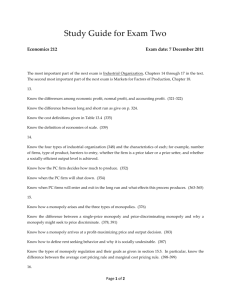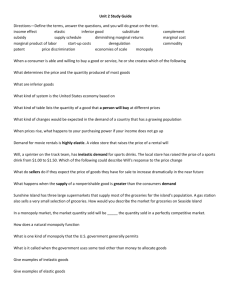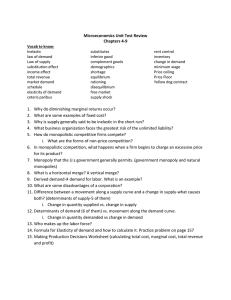the new regulation of consumer the payments and lending industries
advertisement
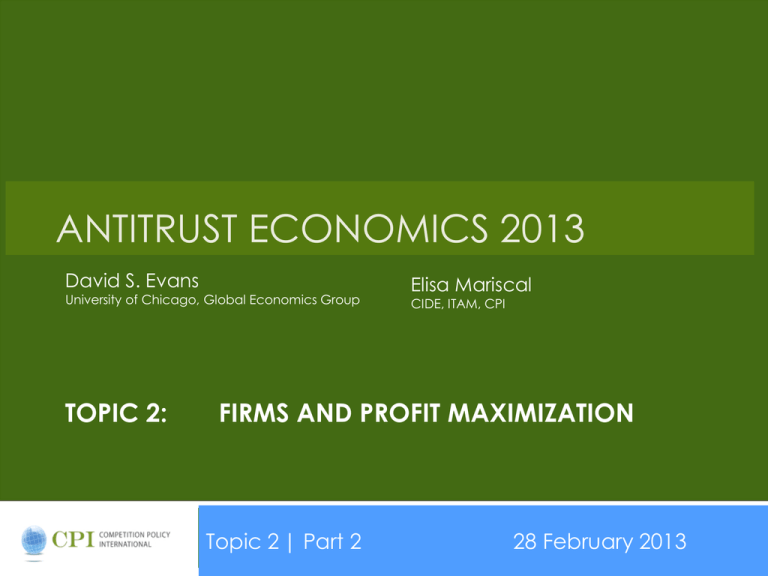
ANTITRUST ECONOMICS 2013 David S. Evans University of Chicago, Global Economics Group TOPIC 2: Date Elisa Mariscal CIDE, ITAM, CPI FIRMS AND PROFIT MAXIMIZATION Topic 2 | Part 2 28 February 2013 Overview 2 Part 1 Part 2 Consumer Demand Profit maximization Firms and the costs of meeting consumer demand Monopoly and market power 3 Profit maximization How to run a profitable business 4 What you know: • You know the demand curve you face. • You know your cost structure. What you need to do: • You need to figure out how much to produce and how much to charge for it in order to maximize profits. • You also need to figure out whether it is worth staying in business. How to run a profitable business 5 When you increase output: • There’s an effect on price – you may need to lower price to get people to take the additional output. • There’s an effect on cost – you need to spend money to produce that extra unit. • For each level of output, ask whether the additional revenue (marginal revenue) you get is greater than the additional cost (marginal cost). • Stop when: Marginal revenue equals marginal cost (i.e. stop when for the next extra unit, marginal revenue is less than marginal cost). MC $ q* MR Q How to run a profitable business 6 Demand: Q = 12 – 2xP or Inverse Demand: P = 6 – 0.5xQ Revenue: R = PxQ = (6 – 0.5xQ)xQ Marginal Revenue: MR = 6 - Q • MR schedule is always steeper than the demand schedule (twice as steep in the case of linear demand as we have above). How to run a profitable business 7 Demand and Marginal Revenue Price Demand Revenue Marginal Revenue 6.0 0.0 0.0 0.0 5.5 1.0 5.5 5.5 5.0 2.0 10.0 4.5 4.5 3.0 13.5 3.5 4.0 4.0 16.0 2.5 3.5 5.0 17.5 1.5 3.0 6.0 18.0 0.5 10 9 8 7 Demand Price 6 5 Marginal Revenue 4 3 2 1 0 0 1 2 3 4 5 6 7 Units 8 9 10 11 12 Maximizing profits – Selecting Optimal Output Level 8 Marginal Cost 10 9 Marginal Cost 8 Price 7 MC=MR gives optimal output level 6 5 4 Demand 3 2 Marginal Revenue 1 0 0 1 2 3 4 5 6 Units 7 8 9 10 11 12 Maximizing profits – Selecting Optimal Output Level 9 Marginal Cost 10 9 8 7 Price Marginal Cost Charge what the market will bear at optimal output 6 5 4 Demand 3 2 Marginal Revenue 1 0 0 1 2 3 4 5 6 Units 7 8 9 10 11 12 When should you give up? 10 Right away if the price is less than short-run average variable cost (you are losing money on every unit if the price is below P3) In the longer run (when you can avoid fixed costs) if price is less than average total cost (P2). Marginal Cost Costs MC ATC AVC P2 P3 Q Predatory Pricing is an application 11 Suppose we observe a company charging a price less than P3. Then, since it would be rational to shut down at this price. We need to ask why it would be acting contrary to its interests. Trying to drive a rival out of business is one possible explanation. Suppose we observe a company charging a price more than P3 but less than P2. Then at least in the short run this is consistent with rational behavior since it is at least covering its variable costs and making a Marginal Cost contribution to fixed costs. Costs MC ATC AVC P2 P3 Q How much money do you make? 12 If a pub varies the price of a pint of beer, how do profits change? Price Profits (thousands) $2.00 $0.00 $2.50 $3.65 $ 8.00 $3.00 $6.65 $ 6.00 $3.50 $8.75 $ 4.00 $4.00 $9.75 $ 2.00 $4.50 $9.80 $5.00 $8.90 $5.50 $5.75 $6.00 $0.00 Total Profit (thousands) $ 12.00 Point with highest profit $ 10.00 $ 0.00 Price What determines Mark-Up? 13 P MC 1 P Where: • P is the Price • MC is Marginal Cost • is the price elasticity of demand facing the firm Elasticity % Markup Example 0.5 200% Wine at a restaurant 1.0 100% Shirts 2.0 50% 3.0 33% 4.0 25% 5.0 20% Milk 14 Monopoly and market power Market power is the ability to influence price, this ability is extreme for a perfect monopoly Perfect Monopoly 15 Entry barriers prevent competition from new comers. The firm faces a downward-sloping demand curve. The profit maximizing price exceeds marginal cost. Quantity supplied is below the competitive level. Perfect Monopoly 16 As with perfect competition, examples of a perfect monopoly are rare. Although not a perfect monopoly, De Beers is likely as close as it gets. • De Beers Group’s Diamond Trading Company (DTC), based in London, sorts, values and currently sells about two thirds of the world’s annual supply of rough diamonds. • In 2003 De Beers produced $8.9 Billion in diamonds. • In 2004, De Beers spent approximately $180 million promoting diamond jewelry in 18 languages, in 16 countries around the world. Perfect Monopoly 17 Consumers are worse-off under perfect monopoly than they are under perfect competition (all other things held constant) Under perfect monopoly, prices are higher and output is lower than under perfect competition MC P PM Surplus lost by consumers PC MR QM D QC Q Monopoly power 18 Almost all firms have some degree of market power that enables them to raise price above marginal cost. They face a downward sloping demand curve and choose the profit maximizing price that corresponds to MR = MC. For competition policy, market power is a matter of degree. It can be measured by how large the deviation is between price and marginal cost or how much greater the risk-adjusted rate of return of the firm is from the competitive level. To understand the sources or consequences of significant market power we consider the extreme case of “monopoly” where there are no substitutes for a firm’s product and it does not have to worry about any competitor. Sources of Monopoly Power 19 Superior efficiency. Some firms are just better at doing things than competitors. This may derive from know-how or superior management. Intellectual property rights – a patent or copyright that prevents others from copying (does a patent necessarily confer monopoly power?); trademarks; and trade secrets. Control of a critical resource such as spectrum rights or diamond mines or a great location. Scale economies in supply that limit the market to one firm (theory of contestable markets suggests that if entry is easy, the market equilibrium is competitive even with one firm). Sources of Monopoly Power 20 Scale economies in demand (direct or indirect network effects) that limit the market to one firm. Other economic “barriers” to entry such as brand image created through advertisement investments. Legal barriers to entry, including licensing, concessions, regulations that favor an incumbent or restrict the number of potential entrants in a market. Anticompetitive behavior including predatory tactics, bid rigging, market-allocation agreements, etc. Scale Economies and Natural Monopoly 21 P D PM ATC PR MC MR QM QR Q Direct Network Effects 22 The value of a product increases with the number of people who use that product. A telephone network is more valuable to each subscriber if there are more people on it. There are more people who can call you and that you can call with a larger network. Like scale economies, direct network effects tend to encourage monopoly. A larger network also beats a smaller network all else equal. Indirect Network Effects 23 Complementary Products: A consumer values a product more if there are more complementary product that increase its value; there are more complementary products if there are more consumers. • e.g. as the number of Apple iPod users increase, the supply of other products that make the iPod more valuable (like docking stations) also increases, making the iPod more valuable. Two-Sided Platforms: Customer A values having access to Customer B. The more A’s on the platform the more valuable it is to the B’s which makes it more valuable to A’s and so forth. • e.g. YouTube is more valuable to viewers if there is more content. It is more valuable to content providers if there are more viewers. Intellectual Property 24 Trade Secrets and Know-How: only Coca-Cola knows the secret of the formula Patents: Legal protections of inventions (duration and coverage varies by country) – Google’s search algorithms are protected by patents. Copyright: Legal protection of written material (duration and coverage varies by country) – books, music and software code are covered. Durability of Monopoly Power 25 Monopoly power is typically greater in the short run than in the long run. A key question for competition policy purposes is how durable is monopoly power. Monopoly power is less durable to the extent that: • Competitors can “invent around” intellectual property rights (e.g. cholesterol-lowering drugs) • Obtain their own specialized assets (Xbox vs. Sony PlayStation) • Develop an alternative production technology or product to meet consumer needs (MCI vs. AT&T in US in late 1970s.) Almost all monopolists are fragile in the long run. But the long run can be many decades. The practical question is how quickly will alternatives to monopoly arise. Fragility of monopoly disciplines exercise of monopoly power 26 Monopoly profits and high prices attract entry A monopoly may keep prices down to a low enough level (“limit price”) to discourage entry. (Why give up profits now rather than just lowering prices when entry occurs?) Extreme case are “contestable markets” where there are no sunk costs and firms can rapidly enter and exit to capitalize on “high” prices. (Economists used to argue that airlines were contestable but evidence shows persistent market power). End of Part 2, Next week Topic 3 27 Part 1 Part 2 Demand and Supply Analysis and Perfect Competition Consumer and Social Welfare Consequences The Effect of Changes on Price and Output in Competitive Markets Merger to Monopoly

